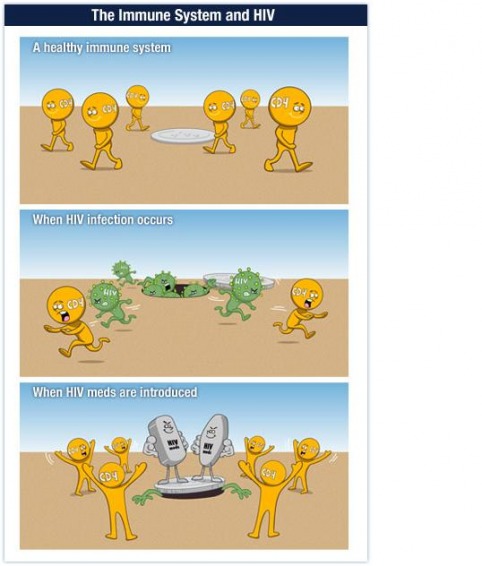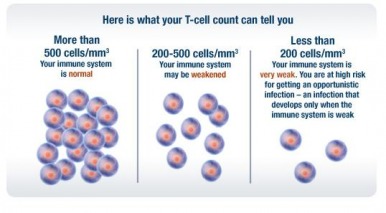The Basics of HIV
HIV (Human Immunodeficiency Virus) is the virus that causes AIDS (Acquired Immunodeficiency Syndrome). Being HIV positive may not mean one has AIDS at the moment, but if HIV is left untreated it can damage the immune system which could lead to AIDS.
What does HIV do to your body?

HIV attacks the immune system, which is made up of cells that fight infection and disease. One of the most important cells that can fight infection is called the CD4 cell, or the “T-helper cell, or T-cell”.
Once HIV is in the body, it infects CD4 (T-Cell) cells and makes copies of itself in these cells. This creates new viruses, and these new viruses are let out into the blood and they continue to infect other CD4 cells, which will kill the CD4 cells, and the count of CD4 cells will potentially go down.
As CD4 cells are lost, the immune system becomes weak, and this makes it harder for the body to fight certain conditions that do not affect most healthy people. These include opportunistic infections (OIS) such as pneumonia, herpes, tuberculosis, and cancers such as lymphoma and cervical cancer
Our society never had the complete control over HIV-AIDS, but there are many ways to help with the treatment of HIV, and help maintain the lives of affected people under the care of the doctors. There are more than 30 drugs or regimens that people could take in order to fight HIV virus, but these drugs cannot and will not completely kill the virus.
Treatments
The recommended treatment for HIV is a combination of three or more meds from at least two different classes. This type of treatment regimen is called Highly Active Antiretroviral Therapy (HAART). By using meds from more than one class, one can fight HIV at different stages of its replication.
Today, there is a wide selection of drug combinations to choose from. HIV drugs may have different side effects, dosing, and number of pills required each day. A number of the drugs are once-a-day-meds.
Many HIV treatment choices, including once-day-day regimens, exist:
**HIV treatment can help lower viral load and icnreased CD4 count.
**Successful HIV treatment may also allow one to live longer.
**The earlier the disease treatment is started, the greater the chance may be for the treatment to be successful.
**Being one treatment and remaining undetectable may also reduce one’s risk of spreading the HIV virus to others.
The recommended treatment for HIV is a combination of three or more meds from at least two different classes. This type of treatment regimen is called Highly Active Antiretroviral Therapy (HAART). By using meds from more than one class, one can fight HIV at different stages of its replication.
Today, there is a wide selection of drug combinations to choose from. HIV drugs may have different side effects, dosing, and number of pills required each day. A number of the drugs are once-a-day-meds.
Many HIV treatment choices, including once-day-day regimens, exist:
**HIV treatment can help lower viral load and icnreased CD4 count.
**Successful HIV treatment may also allow one to live longer.
**The earlier the disease treatment is started, the greater the chance may be for the treatment to be successful.
**Being one treatment and remaining undetectable may also reduce one’s risk of spreading the HIV virus to others.
CD4 cell count

This measures how many infection-fighting cells are in a sample of blood, and it is a way to track how well the immune system is working. HIV treatment should increase CD4 count or at least keep it from going down. CD4 cell counts above 500 cells/mm3 said to be normal. Department of Health and Human Services (DHHS) treatment guidelines advise starting HIV meds when the CD4 count is below 350 cells/mm3. A CD4 count below 200 cells/mm3 means that the immune system is very weak, and it means one of the ways to tell someone with HIV has AIDS.
Drug Resistance Test
This determines which meds may work and which meds won’t work against your HIV virus. If a certain HIV drug does not work against your HIV virus, the virus is said to be "resistant" to that drug. When the HIV virus is resistant to a certain HIV med, the virus can make copies of itself even though you take the drug. Drug resistance can occur two ways. You may be infected with a drug-resistant strain of HIV. Or the strain of HIV you have may suddenly change, which is called a mutation. It is critical that you take your meds every day exactly as prescribed. This is referred to as treatment adherence and it is the key to decreasing drug resistance. Based on the results of your drug resistance tests, your health care provider can choose meds that have a good chance of working against your exact virus.
How to choose the right drugs?
First, talk with your healthcare provider about which HIV treatment plan might work for you. The meds are choosing based on lifestyle, possible side effects, dosing frequency, number of pills, lab values and HIV resistance. There are treatment guidelines that help doctors make suggestions for treatment. These guidelines are provided by the U.S Department of Health and Human Services (DHHS).
What are the Federal HIV treatment guidelines?
The U.S Department of Health and Human Services (HHS) issues guidelines to help doctors treat people with HIV in the U.S. Separate guidelines have been developed for:
-Treatment of adolescents.
-Treatment of children.
-Treatment of pregnant women and prevention of mother-to-child-transmission of HIV.
-Prevention and treatment of opportunistic infections in children.
-Prevention and treatment in adults
What kind of medications should one take when first start the treatment?
Anti-HIV medications are used to control the reproduction of the virus and to show the progression of HIV disease. They are called antiretroviral medications. There are six classes of FDA-approved antiretroviral medications:
• NRTIs (Nucleoside reverse transcriptase inhibitors) “nukes”—a fake building blocks that HIV needs to make more copies of itself. When HIV uses an NRTI instead of a normal building block, reproduction of the virus is slowed.
• NNRTIs (Non-nucleoside reverse transcriptase inhibitors) “non-nukes”—disable a protein that HIV needs to reproduce. The protein is called reverse transcriptase.
• PIs (Protease inhibitors)—disable a protein that HIV needs to reproduce. That protein is called protease.
• Entry/Fusion Inhibitors—work by blocking HIV entry into the cells.
• Integrase Inhibitors—work by blocking the action of the protein integrase. This protein inserts HIV’s genes into the CD4 cells’ genes.
Each HAART regimen is tailored to the individual patient; there is no one “best” regimen. For the people who are taking HAART for the first time, the recommended regimens (in alphabetical order) are:
• Atripla*
• Kaletra** + Truvada
• Lexiva + Norvir + Truvada
• Prezista + Norvir + Travada
• Reyataz + Norvir + Truvada
• Sustiva + Truvada
* Do not use if planning on becoming pregnant or in the first trimester of pregnancy.**** **Do not use once-daily Kaletra in pregnant women.
For more information about the drugs, please visit http://www.aidsdrugsonline.com/en/hiv-medications
What are the negative side effects of HAART?
Possible side effects of HAART include:
Liver problems, Diabetes, High cholesterol, High levels of lactate in the blood, Abnormal fat distribution (lipodystrophy syndrome), Decreased bone density, Skin rash, Nerve problems, and Increased bleeding in patients with hemophilia side effects that may seem minor, such as fever, nausea, and fatigue, can mean there are some serious problems.
This determines which meds may work and which meds won’t work against your HIV virus. If a certain HIV drug does not work against your HIV virus, the virus is said to be "resistant" to that drug. When the HIV virus is resistant to a certain HIV med, the virus can make copies of itself even though you take the drug. Drug resistance can occur two ways. You may be infected with a drug-resistant strain of HIV. Or the strain of HIV you have may suddenly change, which is called a mutation. It is critical that you take your meds every day exactly as prescribed. This is referred to as treatment adherence and it is the key to decreasing drug resistance. Based on the results of your drug resistance tests, your health care provider can choose meds that have a good chance of working against your exact virus.
How to choose the right drugs?
First, talk with your healthcare provider about which HIV treatment plan might work for you. The meds are choosing based on lifestyle, possible side effects, dosing frequency, number of pills, lab values and HIV resistance. There are treatment guidelines that help doctors make suggestions for treatment. These guidelines are provided by the U.S Department of Health and Human Services (DHHS).
What are the Federal HIV treatment guidelines?
The U.S Department of Health and Human Services (HHS) issues guidelines to help doctors treat people with HIV in the U.S. Separate guidelines have been developed for:
-Treatment of adolescents.
-Treatment of children.
-Treatment of pregnant women and prevention of mother-to-child-transmission of HIV.
-Prevention and treatment of opportunistic infections in children.
-Prevention and treatment in adults
What kind of medications should one take when first start the treatment?
Anti-HIV medications are used to control the reproduction of the virus and to show the progression of HIV disease. They are called antiretroviral medications. There are six classes of FDA-approved antiretroviral medications:
• NRTIs (Nucleoside reverse transcriptase inhibitors) “nukes”—a fake building blocks that HIV needs to make more copies of itself. When HIV uses an NRTI instead of a normal building block, reproduction of the virus is slowed.
• NNRTIs (Non-nucleoside reverse transcriptase inhibitors) “non-nukes”—disable a protein that HIV needs to reproduce. The protein is called reverse transcriptase.
• PIs (Protease inhibitors)—disable a protein that HIV needs to reproduce. That protein is called protease.
• Entry/Fusion Inhibitors—work by blocking HIV entry into the cells.
• Integrase Inhibitors—work by blocking the action of the protein integrase. This protein inserts HIV’s genes into the CD4 cells’ genes.
Each HAART regimen is tailored to the individual patient; there is no one “best” regimen. For the people who are taking HAART for the first time, the recommended regimens (in alphabetical order) are:
• Atripla*
• Kaletra** + Truvada
• Lexiva + Norvir + Truvada
• Prezista + Norvir + Travada
• Reyataz + Norvir + Truvada
• Sustiva + Truvada
* Do not use if planning on becoming pregnant or in the first trimester of pregnancy.**** **Do not use once-daily Kaletra in pregnant women.
For more information about the drugs, please visit http://www.aidsdrugsonline.com/en/hiv-medications
What are the negative side effects of HAART?
Possible side effects of HAART include:
Liver problems, Diabetes, High cholesterol, High levels of lactate in the blood, Abnormal fat distribution (lipodystrophy syndrome), Decreased bone density, Skin rash, Nerve problems, and Increased bleeding in patients with hemophilia side effects that may seem minor, such as fever, nausea, and fatigue, can mean there are some serious problems.


